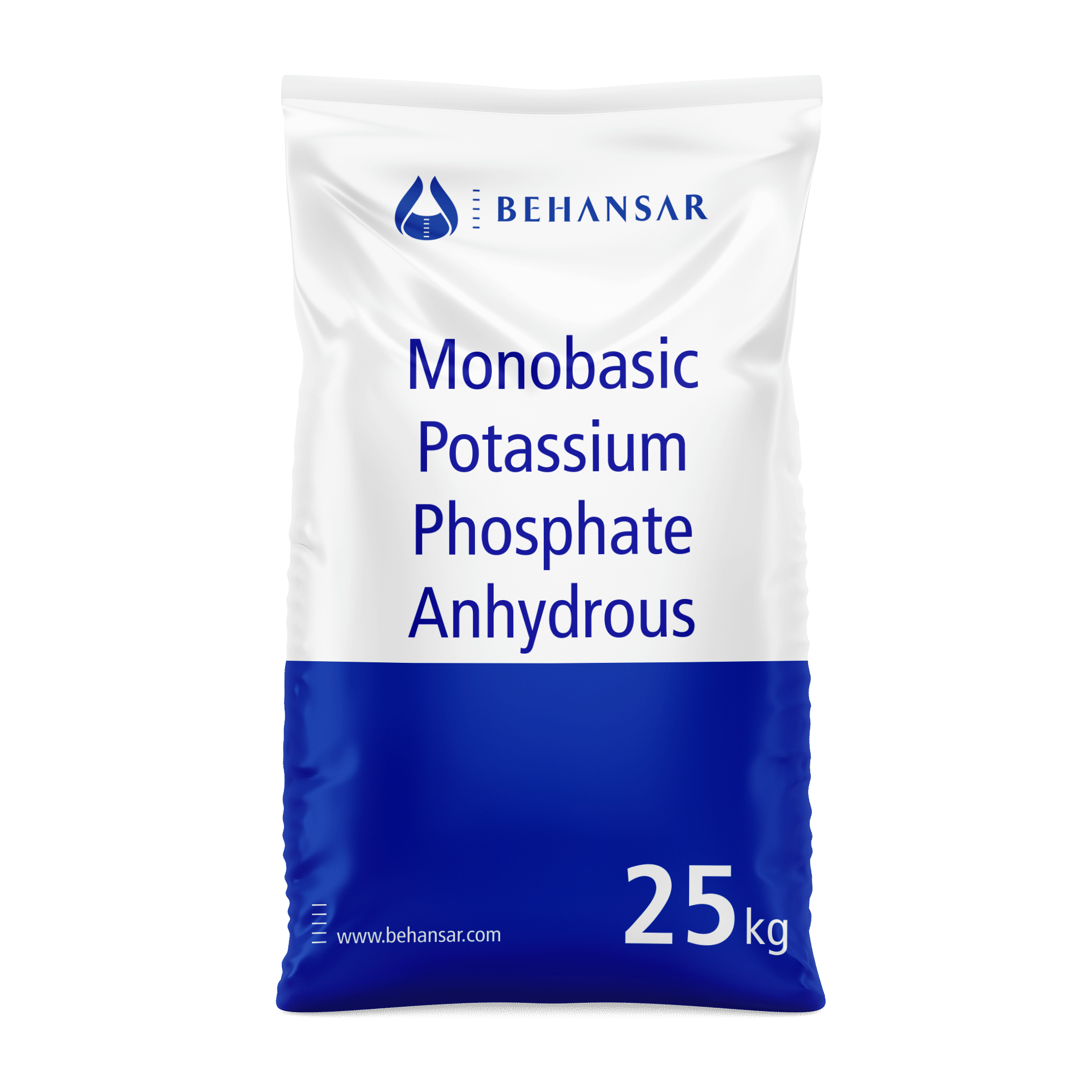Monobasic Potassium Phosphate Anhydrous
| Chemical Formula: | KH₂PO₄ |
| Molecular weight | 136.09 |
| .CAS No: | 7778-77-0 |
| Applications: |

About Monobasic Potassium Phosphate Anhydrous
Potassium phosphate is a generic term for the salts of potassium and phosphate ions including:
- Monopotassium phosphate (KH2PO4) (Molar mass approx: 136 g/mol)
- Dipotassium phosphate (K2HPO4) (Molar mass approx: 174 g/mol)
- Tripotassium phosphate (K3PO4) (Molar mass approx: 212.27 g/mol)
Potassium is the major cation of intracellular fluid and is essential for maintenance of acid-base balance, isotonicity, and electrodynamic characteristics of the cell. Potassium is an important activator in many enzymatic reactions and is essential to a number of physiologic processes including transmission of nerve impulses; contraction of cardiac, smooth, and skeletal muscles; gastric secretion; renal function; tissue synthesis; and carbohydrate metabolism.
Phosphate is a major intracellular anion that participates in providing energy for metabolism of substrates and contributes to important metabolic and enzymatic reactions in almost all organs and tissues. Phosphate exerts a modifying influence on calcium concentrations, a buffering effect on acid-base equilibrium, and has a major role in the renal excretion of hydrogen ions. Phosphorus has a number of important functions in the biochemistry of the body. The bulk of the body\'s phosphorus is located in the bones, where it plays a key role in osteoblastic and osteoclastic activities. Enzymatically catalyzed phosphate-transfer reactions are numerous and vital in the metabolism of carbohydrate, lipid and protein, and a proper concentration of the anion is of primary importance in assuring an orderly biochemical sequence. ln addition, phosphorus plays an important role in modifying steady-state tissue concentrations of calcium. Phosphate ions are important buffers of the intracellular fluid, and also play a primary role in the renal excretion of the hydrogen ion. Oral administration of inorganic phosphates increases serum phosphate levels. Phosphates lower urinary calcium levels in idiopathic hypercalciuria.
Potassium phosphate injection is a phosphate replacement that is used to treat or prevent hypophosphatemia (low phosphorus in the blood). It is also used as an additive in the preparation of fluid formula injections. This medicine is given to patients who cannot receive a phosphate supplement by mouth.
Monopotassium phosphate is an ionic compound used for electrolyte replenishment and total parenteral nutrition (TPN) therapy. Together with dipotassium phosphate, it is often used as a fertilizer, food additive, and buffering agent. The salt often cocrystallizes with the dipotassium salt as well as with phosphoric acid. It can be used in fertilizer mixtures to reduce escape of ammonia by keeping pH low. In food industry, it is used as emulsifier, pH control agent, and stabilizer or thickener in foods.
As a buffering agent, it is exploited in buffers (determination of pH, pharmaceutical production, urinary acidifier, paper processing, baking powder, and food), nutrient solutions, yeast foods, special liquid fertilizers, sonar systems and other electronic applications.
As a crystal, Monopotassium phosphate (MKP) is noted for its non-linear optical properties. Used in optical modulators and for non-linear optics such as second-harmonic generation (SHG).
Monopotassium phosphate is used as an ingredient in sports drinks such as Gatorade and Powerade.
As a food additive, dipotassium phosphate is categorized by the United States Food and Drug Administration as generally recognized as safe (GRAS). Dipotassium phosphate is used in imitation dairy creamers, dry powder beverages, mineral supplements, and starter cultures. It functions as an emulsifier, stabilizer and texturizer; it also is a buffering agent, and chelating agent especially for the calcium in milk products.
Tripotassium phosphate can be used in foods as a buffering agent, emulsifying agent, and for nutrient fortification. It can serve as a sodium-free substitute for trisodium phosphate. The ingredient is most common in dry cereals but is also found in meat, sauces, and cheeses.
| Product Number | Product Name | Form | Pharmacopoeia | Solvency | Storage conditions | Color | Purity | Additional information |
|---|---|---|---|---|---|---|---|---|
| 151300027 | Monobasic Potassium Phosphate Anhydrous | Powder | USP | Freely soluble in water; practically insoluble in alcohol. | Preserve in tight containers. | Colorless crystals or white, granular or crystalline powder | 98.0%-100.5% |

